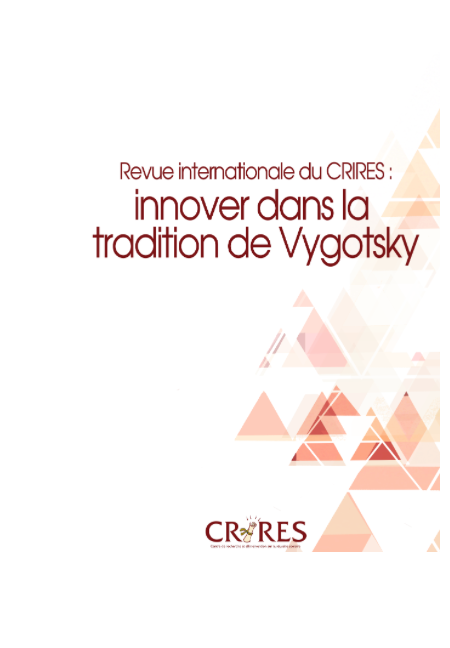Creative and social activities in Minecraft: How a video game is mobilized into a social digital literacy approach
DOI:
https://doi.org/10.51657/975h8654Keywords:
digital culture, digital objects, pairs, digital gamesAbstract
Although interest in children's digital culture in early childhood education is on the rise, research has so far paid limited attention to their digital culture in informal contexts. Our research question is as follows: what are the social and digital literacy implications of children's informal activity in digital games? Drawing inspiration from socio-material theorization as well as Rogoff's work (2014), we explore the social activity of creation within virtual environments. In our case study, we identify two main dimensions: resources for creating digital objects and the social status of digital objects. The interaction between the material and virtual world reveals the richness of dialogues between actors and objects, both inside and outside of games, suggesting new modes of play and engagement with reality.
References
Clapp, E. P., Ross, J., Ryan, J. O., & Tishman, S. (2016). Maker-centered learning: Empowering young people to shape their worlds. John Wiley & Sons. https://pz.harvard.edu/resources/maker-centered-learning-empowering-young-people-to-shape-their-worlds
Culpepper, M. K., & Gauntlett, D. (2020). Making and learning together: Where the maker space mindset meets platforms for creativity. Global Studies of Childhood, 10(3), 264-274. https://doi.org/10.1177/2043610620941868
De Freitas, E., & Palmer, A. (2016). How scientific concepts come to matter in early childhood curriculum: Rethinking the concept of force. Cultural Studies of Science Education, 11(4), 1201-1222. https://doi.org/10.1007/s11422-014-9652-6
Dezuanni, M. (2020). "Minecraft' worldness' in Family Life." The Routledge Handbook of Digital Literacies in Early Childhood. 1st ed. Routledge. 366-376.
Deuze, M. (2012). Media Life. Polity.
Driver, R. (1989). Students' Conceptions and the Learning of Science. International Journal of Science Education 11(5), 481-490. https://doi.org/10.1080/0950069890110501
Hewett, K. J., Zeng, G., & Pletcher, B. C. (2020). The acquisition of 21st-century skills through video games: Minecraft design process models and their web of class roles. Simulation & Gaming, 51(3), 336-364. https://doi.org/10.1177/1046878120904976
Klein, G., Moon B., Hoffman, R.F. (2006). Making sense of sense-making: Alternative perspectives. IEEE Intelligent Systems 21(4), 70–73.
Kumpulainen, K., Gillen, J. (2017). A review of literature on young children's digital literacy practices in the home. https://digiliteymethodscorner.files.wordpress.com/2018/10/wg1-kumpulainen_gillen_lit-review-2017.pdf
Kajamaa, A., & Kumpulainen, K. (2019). Agency in the making: analyzing students' transformative agency in a school-based maker space. Mind, Culture, and Activity, 26(3), 266-281. https://doi.org/10.1080/10749039.2019.1647547
Kumpulainen, K., & Kajamaa, A. (2020). Sociomaterial movements of students' engagement in a school's maker space. British Journal of Educational Technology, 51(4), 1292-1307. https://doi.org/10.1111/bjet.12932
Law, N., Woo, D., de la Torre, J., & Wong, G. (2018). A global framework of reference on digital literacy skills for indicator 4.4.2. UNESCO Institute for Statistics. http://uis.unesco.org/sites/default/files/documents/ip51-global-framework-reference-digital-literacy-skills-2018-en.pdf
Mayring, P. (2014). Qualitative content analysis: theoretical foundation, basic procedures and software solution. Klagenfurt, 2014. URN: http://nbn-resolving.de/urn:nbn:de:0168-ssoar-395173
Mehto, V., Riikonen, S., Hakkarainen, K., Kangas, K., et Seitamaa‐Hakkarainen, P. (2020). Epistemic roles of materiality within a collaborative invention project at a secondary school. British Journal of Educational Technology, 51(4), 1246-1261. http://dx.doi.org/10.1111/bjet.12942
Nebel, S., Schneider, S., & Rey, G. D. (2016). Mining learning and crafting scientific experiments: a literature review on the use of Minecraft in education and research. Journal of Educational Technology & Society, 19(2), 355-366. https://www.jstor.org/stable/jeductechsoci.19.2.355
Niiranen, S. (2021). The learning-by-doing approach supports the development of students' technological understanding in craft and technology education. International Journal of Technology and Design Education, 31(1), 81-93. https://doi.org/10.1007/s10798-019-09546-0
Paavola, S., et Miettinen, R. (2019). Dynamics of design collaboration: BIM models as intermediary digital objects. Computer supported cooperative work, 28(1), 1-23. http://dx.doi.org/10.1007/s10606-018-9306-4
Pettersen, K., Arnseth, H. C., & Silseth, K. (2022). Playing Minecraft: Young children's postdigital play. Journal of Early Childhood Literacy. https://doi.org/14687984221118977.
Rogoff, B. (2003). The cultural nature of human development. Oxford university press.
Rogoff, B. (2014). Learning by observing and pitching in to family and community endeavors: An orientation. Human development, 57(2-3), 69-81.
Riikonen, S. M., Kangas, K., Kokko, S., Korhonen, T., Hakkarainen, K., et Seitamaa-Hakkarainen, P. (2020). The Development of Pedagogical Infrastructures in Three Cycles of Maker-Ceb ntered Learning Projects. Design and Technology Education, 25(2), 29-49.
Rivero, E., & Gutiérrez, K. (2022). Children Learning by Observing and Pitching In to community endeavours in online gaming communities. Journal for the Study of Education and Development, 1-10.
Sairanen, H., Kumpulainen, K. & Kajamaa, A. (2022) An investigation into children's agency: children's initiatives and practitioners' responses in Finnish early childhood education. Early Child Development and Care, 192(1), 112-123. https://doi.org/10.1080/03004430.2020.1739030
Sheridan, K., Halverson, E. R., Litts, B., Brahms, L., Jacobs-Priebe, L., & Owens, T. (2014). Learning in the making: A comparative case study of three makerspaces. Harvard Educational Review, 84(4), 505-531
Streeck, J., Goodwin, C., & LeBaron, C. (Eds.). (2011). Embodied interaction: Language and body in the material world. Cambridge University Press.
Valkonen, S., Kupiainen, R., & Dezuanni, M. (2020). Constructing social participation around digital making: A Case study of multiliteracy learning in a Finnish day care center. Journal of Early Childhood Education Research, 9(2), 477-497.
von Glaserfeld, E. (1989). Cognition, Construction of Knowledge, and Teaching in History, Philosophy, and Science Teaching. Synthese (Dordrecht) 80(1), 121-140.
Downloads
Published
Issue
Section
License
Copyright (c) 2024 Maria Antonietta Impedovo

This work is licensed under a Creative Commons Attribution-NonCommercial-NoDerivatives 4.0 International License.

